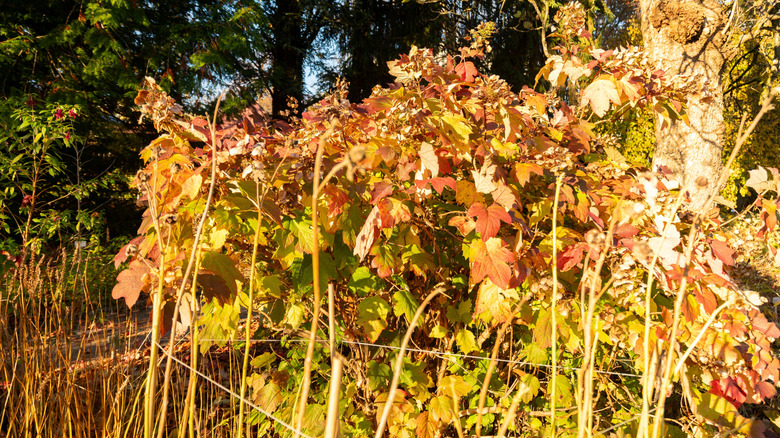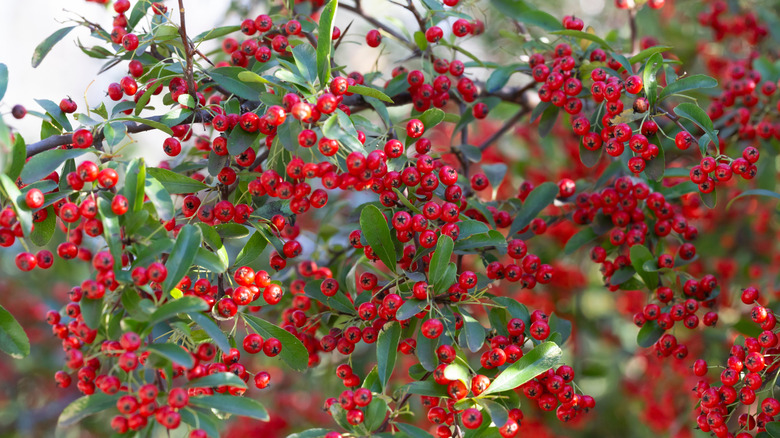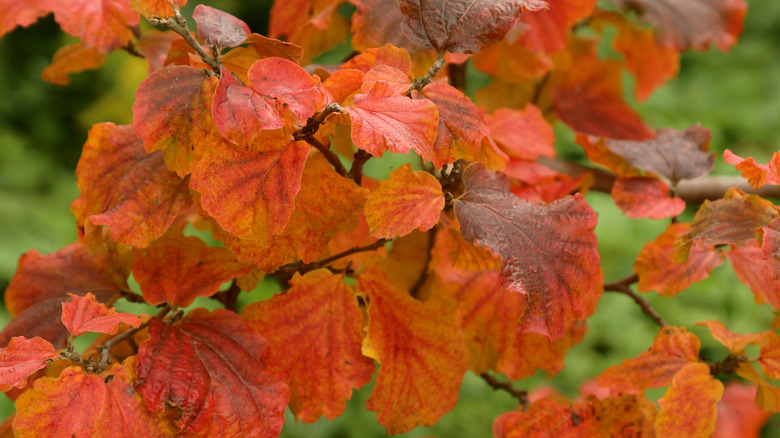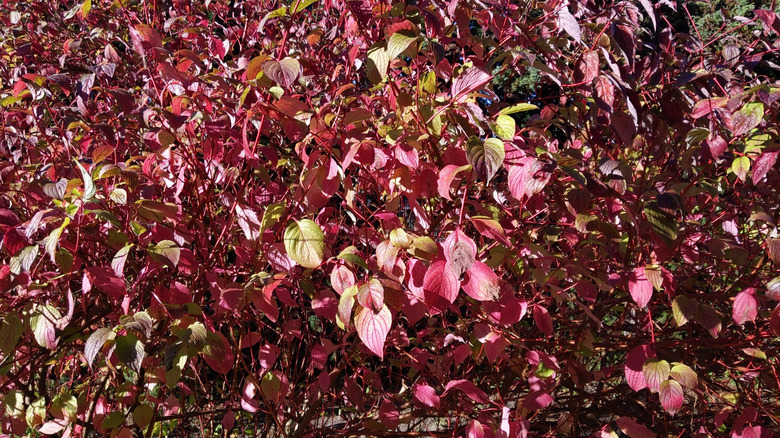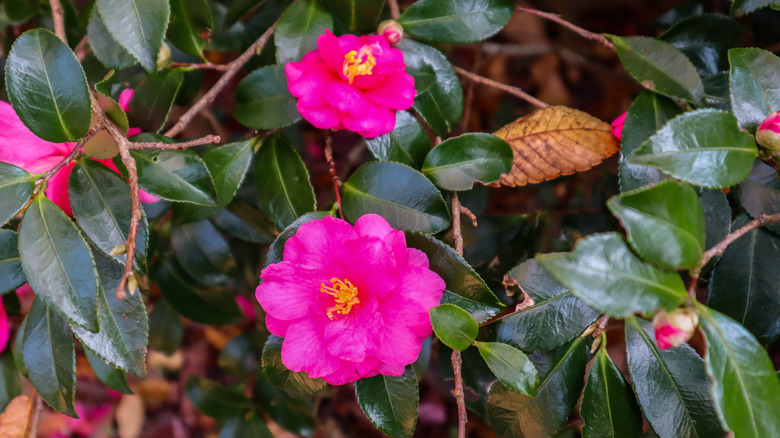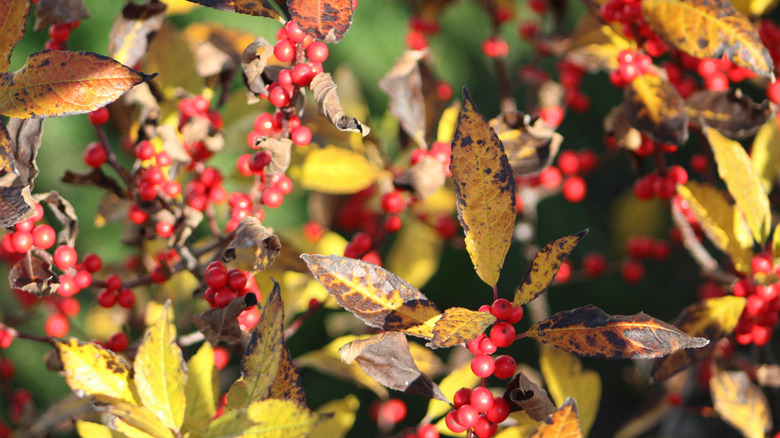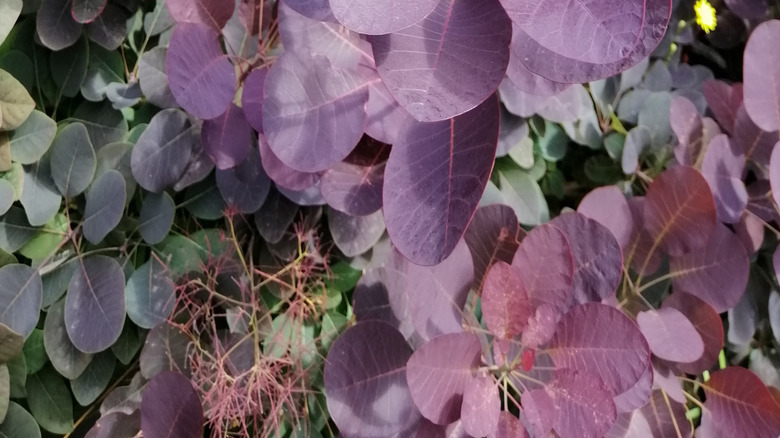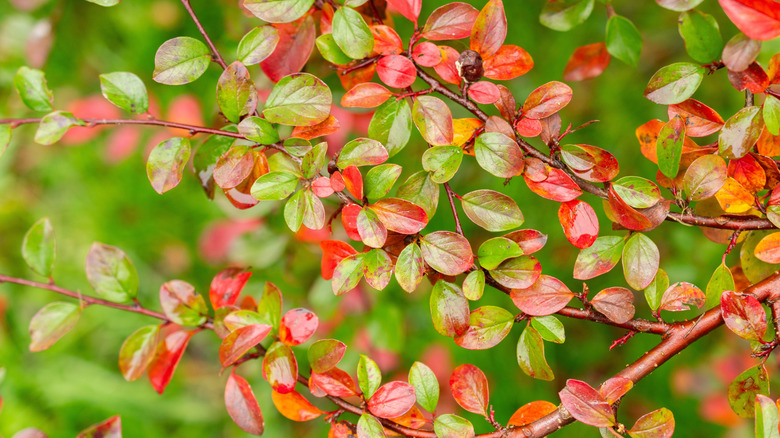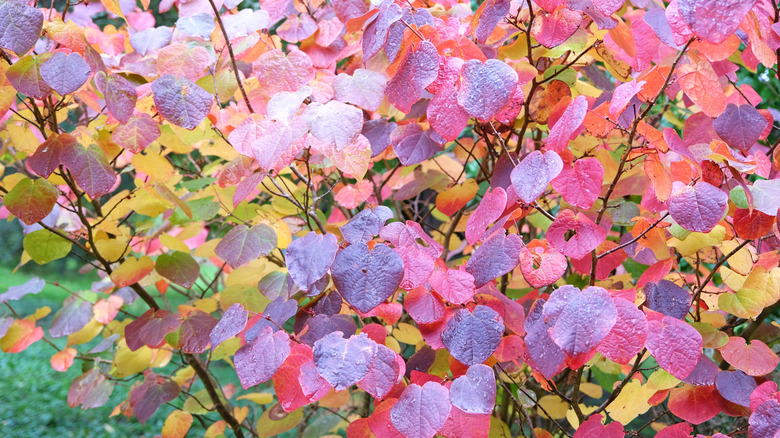14 Colorful Shrubs Perfect For Autumn Border Gardens
Autumn is truly magical. Trees glow in sunset yellows, burnished oranges, or bonfire reds, while frantic squirrels dash around, hoarding nuts. Yet, there's more beauty to discover in this chilly weather — in your border gardens — if you plan thoughtfully. Used to mark boundaries, serve as natural fences or property lines, edge walkways, or delineate lawns from flower beds and hedges, border gardens feature a host of mixed plantings. While annuals and perennials provide color during the growing season, shrubs are relegated to hum-drum green backdrops that give structure to the borders.
But shrubs can do much more in your fall displays. Shrubs like 'Kaleidoscope' glossy abelia (Abelia × grandiflora 'Kaleidoscope'), large fothergilla (Fothergilla major), and oakleaf hydrangeas (Hydrangea quercifolia) can brighten autumn border gardens with their flamboyant foliage. In short, through their fall-changing leaves, flowers, pretty berries, or sculptural stems, shrubs can inject a jolt of color into dormant landscapes. The key to achieving that? Ensuring they're hardy to your climate and have enough space to bush out. Ready to make your borders pop this autumn? Here are 14 colorful selections to consider.
American beautyberry's berries inject a burst of magenta in sunny borders
Native to the southeast and central U.S., American beautyberry (Callicarpa americana) is a gorgeous specimen and can become the highlight of your autumn border garden. After exhausting its pale pink blooms in the summer, its branches become laden with fruit clusters. These dry down to black raisin-like blobs atop leafless stems in the winter, retaining ornamental and food value for small mammals. American beautyberries also offer chartreuse yellow fall colors.
These shrubs tend to sprawl outward as they mature, and should be placed at the back of the border where their open habit and self-seeding won't become problematic. Prune this bird-loving shrub in late winter for bushier, lush spring growth. For the best berry displays, plant American beautyberry in full sun and moist, well-drained soil; while the shrubs are self-fertile, planting multiples can boost fruit production. They grow well in USDA Zones 6 to 10, and once established, they tolerate heat, drought, and light shade quite well.
Black chokeberry's fall foliage and fruits provide a beautiful backdrop in a range of sites
Black chokeberries (Aronia melanocarpa), native to the eastern U.S., offer a beautiful accent in autumn borders. September or so onward, their brownish-red stems feature highly ornamental, blackish-purple fruits that are sought-after by resident birds and small mammals. Meanwhile, the glossy green leaves adopt a burgundy or purple form until they're shed in winter. Cultivars like 'Autumn Magic' and 'Viking' boast a spectacular red form in the fall.
Black chokeberries are highly versatile. They take well to flooded sites and can be utilized in rain gardens to reduce soil erosion while beautifying your yard. They're also great for dry sites, as they can handle drought. Black chokeberries flourish with full sun exposure, though they may tolerate moderate shading (at the cost of fruiting) in zones 3 through 8. They're available in a range of mature sizes, varying between 3 and 10 feet, and can be positioned accordingly in borders. That being said, remember that deer and rabbits browse their foliage.
'Kaleidoscope' glossy abelia delivers gorgeous color year-round in mild climates
'Kaleidoscope' glossy abelia (Abelia x grandiflora 'Kaleidoscope') is a low-growing shrub that changes color year-round. New leaves emerge greenish-yellow and turn a blazing gold in the summer, creating a striking contrast with the red stems. In the fall, they make an awe-worthy statement when they transform into fiery reds and russet oranges. This display lasts through the winter in mild climates where 'Kaleidoscope' is evergreen. Their blooming pink buds mixed with tubular, white flowers add to their charm.
To encourage 'Kaleidoscope' glossy abelia to produce its best colors, plant it in a site exposed to direct sunlight for over six hours. You may grow it as a mini hedge to deter deer. It works great in front of sloped borders to check soil erosion and in coastal gardens, as it tolerates salt sprays. It grows successfully in zones 6 through 9.
Oakleaf hydrangea offers spectacular color in shaded, autumn borders
Oakleaf hydrangea (Hydrangea quercifolia) is the hydrangea variety you should plant for gorgeous color in the fall. Its oak-shaped leaves turn a vibrant mix of mahogany, wine red, and orange during chilly weather, offering copious interest. Once they drop, peeling stems deliver winter appeal as the cinnamon-colored underlayer is revealed. Outside of the cold season, oakleaf hydrangeas are prized for their white blooms that appear during spring and summer.
Oakleaf hydrangeas will appeal to many gardeners. In case you maintain a pollinator garden, mass plant these shrubs to attract butterflies and birds. They're also excellent for woodland borders, as they enjoy partial shade and moist soils. Since they can grow up to 8 feet tall and similarly wide, place oakleaf hydrangeas at the back of the border. These drought-tolerant shrubs overwinter successfully in zones 6 through 9, and may survive in zone 5 if shielded from desiccating winter winds. Mulching will help, too.
'Tiger Eyes' staghorn sumac is sized perfectly for small border gardens
Standard staghorn sumac specimens don't have the best reputation in gardens because they sucker profusely, requiring constant maintenance. Fortunately, the cultivar 'Tiger Eyes' (Rhus typhina 'Bailtiger') is well-behaved and makes a beautiful addition even in the smallest gardens. During spring, its lacy leaves are chartreuse until they grow golden (and remain so without any scorch) through the hottest summers. The real show begins in autumn when the foliage turns a bright scarlet-orange, contrasting stunningly against the hairy, purple branches. Moreover, these shrubs may produce fruits that can help keep the birds fed through the winter.
'Tiger Eyes' staghorn sumac can grow over 6 feet tall and may be placed in the middle or the back of the shrub border. The feathery textures of their leaves are particularly valuable to soften the transition from lawns to gardens. These beautiful plants will tolerate clay soil when drainage is reasonable. Hardy in Zones 4–8, they also handle light shade, though the colors are brightest when the plant gets full sun.
Red chokeberry fires up wet sites with red fruits and foliage
Want shrubs that attract birds to your yard for fun feathered sightings, and add sprightly color to your borders? Check out red chokeberry (Aronia arbutifolia). Around September, it produces vivid red fruits that have a chokehold on cedar waxwings, thrashers, vireos, and mockingbirds, despite the astringent taste. These fruits remain suspended on the stems until at least December, extending fall interest into peak winters. Moreover, like many deciduous trees, these shrubs don a red overcoat in October, providing a gorgeous backdrop to foreground plants.
Red chokeberries are native to the eastern United States and may be grown in zones 3 to 9. They're a valuable addition in challenging sites. For instance, they thrive in boggy, wet areas where most plants struggle. Pruned every year, they maintain a bushy appearance that can double as an ornamental hedge. Most varieties grow over 6 feet tall and look great massed in the middle of the borders.
Spice up autumn borders with the blazing foliage of large fothergilla
With large fothergilla (Fothergilla major), or large witch alder, you can expect a stunning visual interest not just in the fall, but year-round. Spring sees them covered in bottlebrush-like brooms that invite pollinators and gardeners alike with their honeyed fragrance. When the weather cools, the waxy, bluish-green foliage turns a stunning red, bronze, or orange, depending on the cultivar, amount of rainfall, and overall temperature. Even after their stems become bare in winter, large fothergilla shrubs offer interest through their fan-like form, becoming even more prominent as snow flurries accumulate on top of them.
Large fothergilla is native to moist, acidic woodlands and mountain slopes in the southeastern United States and thrives in USDA Zones 4 through 8. It prefers well-drained, acidic soil and grows best in full sun to partial shade, with the most vibrant fall colors relying on plenty of sun exposure. Mature plants can reach 8 to 10 feet tall, making them ideal for the back of a layered border and beautiful companions for rhododendrons. While tolerant of clay and moist conditions, they may suffer in standing water and prolonged drought. Fothergillas are generally deer-resistant, though very hungry deer may occasionally browse young growth.
Red osier dogwood offers striking fall interest in poorly-draining sites
If you're looking for a native shrub that grows quickly and densely plus showcases stunning fall displays, consider red osier dogwood (Cornus sericea). From late summer onward, bluish-white fruits cluster around its silky stems, drawing in catbirds, finches, woodpeckers, kingbirds, and thrushes. These fruits persist into fall, beautifully complementing the vibrant stems, as their colors deepen with the cooling temperatures. The highlight is the foliage, turning orange and deepening into red, then purple, before dropping. The leafless shrub strikes a dramatic pose in winter, with its red-hot or yellow stems (cultivar-dependent) curving into a vase shape against the snow-covered ground or in combination with evergreens.
Red osier dogwoods are highly adaptable. They prefer acidic to neutral soil but will also tolerate alkaline. Poorly-draining sites, on account of clay, compaction, swamps, or bordering ponds and streams, are actually favored. But they'll readily produce clones in such sites. While this can work out great if you want rapid coverage, a thick screen along property lines, or to prevent soil erosion, you'll have to spade out the errant roots. Red osier dogwoods offer the best display when planted in full sun. While they'll remain showy in moderate shade, flowering and fruiting will take a hit.
'Henry's Garnet' sweetspire forms a carefree background in woodland borders
With leaves glowing a deep crimson, 'Henry's Garnet' sweetspire (Itea virginica 'Henry's Garnet) makes a lovely addition in autumn borders. Better yet, this display lasts a long time, often continuing into early winter days. While this shrub has a bare phase in late winter, it kicks off the spring season by sprouting burgundy-green leaves from purplish-red stems. As the weather warms, the leaves become greener while stems run through shades of red, brown, and green in succession. Fragrant, white blooms are another bonus, thus ensuring multi-season interest.
'Henry's Garnet' sweetspire does best in moist to wet soils and tolerates a range of textures, from loam to clay, thriving in acidic to neutral conditions. While it naturally spreads by suckering—especially in moist, fertile ground—you can remove unwanted shoots to keep the shrub contained. This versatile native brightens shaded nooks and woodland borders, producing excellent flowering and foliage color with as little as four hours of sun. It is hardy in Zones 5 to 9 and generally pest-free, making it a reliable, low-maintenance shrub as long as it receives consistent moisture.
Sasanqua camellias add structure to autumn borders
Sasanqua camellia (Camellia sasanqua) does not rely on foliage or berries to bring beauty to fall borders. Instead, it enlivens the area with its perfumed blooms that appear in waves from September to December. Given the wide selection, you can find shrubs with pink, red, or variegated petals, classified further into single or double forms. If we're playing favorites, though, we'll recommend checking out 'ShiShi Gashira.' Its hot pink, semi-double flowers are breathtaking, while the weeping, evergreen foliage offers the perfect backdrop.
Be careful with your Sasanqua camellias, as their leaves will burn if the site becomes dry. In other words, you'll need to locate them in borders that are either well-watered or shaded during the afternoon. They're also likely to become unhappy in alkaline soils, showing yellowing leaves, unless the substrate is amended with chelated iron. With sasanqua camellias, you also need to look out for aphids, scales, and spider mites. Overall, if you're ready to care for these shrubs, they'll add beauty and structure to borders with their over 6-foot-tall physique.
Winterberry looks lovely in borders flanking ponds
Established winterberry (Ilex verticillata) shrubs weave a spectacular display in autumn with their plump, vibrantly red berries paired against golden foliage. The legion of cedar waxwings, northern mockingbirds, and other local birds that pluck off these berries or use the shrubs for cover further animate the landscape. Despite their popularity, these berries usually last into early spring months, offering ample visual appeal against the gracefully arching stems during winter. You may also use their fruiting branches along with other budget-friendly flowers for a perfect fall bouquet or winter arrangements.
To enjoy these fall benefits, grow several varieties with overlapping flowering periods. Winterberries have separate female and male forms, and both must be grown together for berry production. A lone male pollinator like 'Jim Dandy' can generally pollinate about 10 female plants. Also, ensure their soil doesn't dry out. Winterberries are native to the eastern United States and show tolerance for city conditions, including pollution, compaction, and salt drift. Since they perform well in heavy, wet soils, they make excellent borders around ponds and streams. But the soils should be acidic. Standard specimens can grow about 12 feet tall, offering vertical structure, though cultivars like 'Afterglow' and 'Red Sprite' are more compact and can be utilized in front of the border. Deer tend to leave them alone. You may grow them in zones 3 to 8.
'Royal Purple' smoketree adds smoky drama to dry borders
'Royal Purple' smoketree (Cotinus coggygria 'Royal Purple') was named so for the fluffy puffs of pinkish-purple hairs that develop on the spent flower stalks, giving off the impression that it's up in smoke. While this makes a theatrical view in summer, the baton for fall interest is passed on to the red leaves, which grow purple over time. Eventually, they turn a much deeper, richer purple.
To experience 'Royal Purple' at its best, locate it in a site receiving over six hours of direct sunlight. If you only care for fall colors, cut back its foliage to the ground every spring to encourage new growth with richer colors. But if you'd like to keep the flowery plumes, thin the oldest stems every three years or so. 'Royal Purple' can grow quite tall and wide at over 12 feet, and is best utilized as a specimen or accent in shrub borders. It overwinters successfully in zones 4 to 8 but may not survive for long in poorly drained soils.
Spreading cotoneaster makes an attractive clipped hedge in autumn borders
Spreading cotoneaster (Cotoneaster divaricatus) can be a valuable addition to border gardens. In fall, it boasts multiple clusters of egg-shaped, red berries, which lure in birds as they remain on stems throughout the winter. Dropping temperatures coax the green leaves into assuming autumnal shades of orange and red. This will give you a glowing display, especially when backlit by the sun. Just remember that Cotoneaster divaricatus is considered invasive or potentially invasive in parts of the northeastern and midwestern United States, so check with your local agricultural extension before planting.
Spreading cotoneaster is ideal for busy gardeners. You can neglect the plant after it has established, and don't have to worry about pruning or fertilizing it if you don't mind a bit of leggy growth. However, those who enjoy formal borders can shear it into the desired shape without compromising its vigor. Additionally, mulch the beds to keep weeds down. Spreading cotoneasters grow well with full-to-part sun exposure in zones 4 to 7.
Redbud hazel delivers excellent fall color in heavily shaded sites
A part of the witch hazel family, redbud hazel (Disanthus cercidifolius) is certain to augment your autumn borders with leaps and bounds. The foliage on this vase-shaped shrub transforms from bluish-green to red as fall sets in and intensifies into winter, carrying undertones of orange and purple. What makes redbud hazel stand out is its ability to thrive in light to moderate shade, especially in woodland settings. Even without full sun, it develops rich, multicolored fall foliage, though the most brilliant reds and purples appear when the plant receives at least some direct or filtered light.
Redbud hazel prefers moist, acidic, well-drained woodland soils and, luckily for those with shaded yards, it thrives in partial shade. It typically grows 5 to 10 feet tall if unpruned and is hardy in Zones 5–8. The shrub is considered moderately deer-resistant. While deer may nibble new growth on occasion, it is not a plant they typically gorge on.




